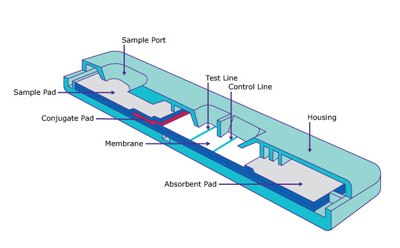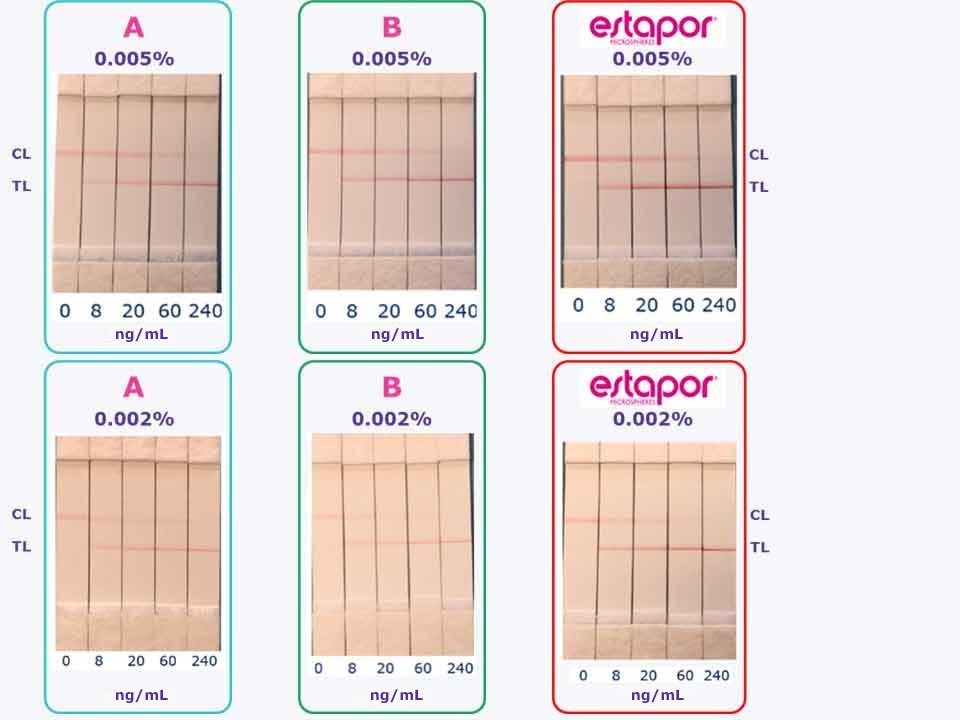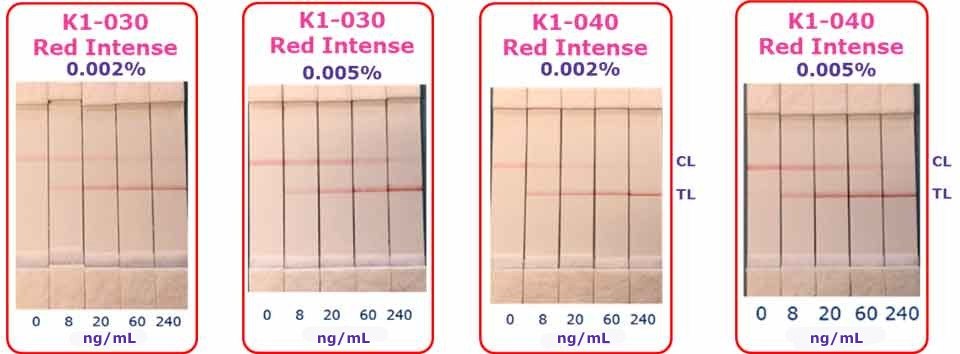Estapor® Red Intense Microspheres in Lateral Flow
Read more about
- Comparison Study with Recognized Competitor Microspheres in a Model HBsAg Antigen Assay
- Introducing Intense Microspheres for Lateral Flow Assays
- Comparison of Estapor® Red Intense Dyed Microsphere Performance in a Lateral Flow Assay
- Conclusions on the Lateral Flow Assay Performance Comparison using Estapor® Red Intense Microspheres
- Microsphere Comparison Experimental Section
- Conjugation Protocol
- Related Products
Next generation lateral flow tests (LFTs) must be highly sensitive to allow early detection of pathogens, easy to use (rapid and readable) to allow for home utilization and cost effective to allow their distribution at mass scale. Moreover, the trend now is the use of microspheres for multiplex LFTs which use various colored microspheres to indicate the presence of multiple analytes.
To address these challenges, we are developing a new portfolio of intense-colored, carboxylated microspheres featuring the following unique advantages:
- Improved assay sensitivity through greater signal intensity
- Easy reading, even at low conjugate concentration
- Stable conjugates through easy covalent binding to the carboxyl-modified microspheres
- Reproducible results due to high monodispersity and color stability
- Cost effective
- Versatile with a range of 2 diameters available at 300 nm and 400 nm
Introducing Intense Microspheres for Lateral Flow Assays
Lateral flow tests (Figure 1) are simple, rapid, and cost-effective technology for diagnostics applications. LFT-based assays are used in home, hospitals, physician’s offices, and clinical labs for the detection of specific antigens and antibodies.

Figure 1.Lateral flow test strip design.
The massive use of LFTs during the COVID-19 pandemic demonstrates their acceptability by a large range of the worldwide population, thus creating a demand for the development of next generation designs.
Next generation LFTs must be highly sensitive to allow early detection of pathogens, easy to use (rapid and readable) to allow for home utilization and cost effective for distribution at mass scale. There is increased demand for use of colored microspheres for multiplex LFTs to indicate the presence of multiple analytes, for example to differentiate virus strains.
To address these challenges, our Estapor® R&D scientists and engineers are developing a new set of intense-colored microspheres for use as highly sensitive detector reagents. The first of this new portfolio available are Estapor® K1-030 Red Intense and K1-040 Red Intense (Table 1), highly monodispersed (Figure 2), carboxyl modified polystyrene microspheres with a diameter of 300 nm or 400 nm.
In this report, we compare the applicative performance of the Estapor® Red Intense microspheres with recognized competitor microspheres in a model HBsAg antigen assay.

Figure 2.High monodispersity illustrated by TEM analysis of Estapor® K1-030 Red Intense (left) and K1-040 Red Intense (right).
Comparison of Estapor® Red Intense Dyed Microsphere performance in a lateral flow assay
To illustrate the performance of Estapor® Red Intense microspheres, we have selected HBsAg detection as a model assay. Microspheres were conjugated to antibodies using our standard two-step EDC/Sulfo-NHS covalent coupling process (see Experimental Section for detailed procedure).
The new reference K1-040 Red Intense was also compared with key competitor microspheres, widely used as reference detector reagents in LFTs. For this purpose, two different carboxyl modified microspheres (noted A and B) with same size of 400 nm and color were tested using the same assay conditions.
A first set of experiments was run with a conjugate concentration of 0.005% (Figure 3 – upper row). At this conjugate concentration, all tests show readable test and control lines, but Estapor® K1-040 Red Intense gave the most intense signal making the result easier to read.
To further assess the gain of sensitivity obtained using Red Intense microspheres, we decreased the conjugate concentration down to 0.002% (Figure 3 – lower row). At this concentration, only K1-040 Red Intense still gives a clearly readable signal where competitor microspheres signal is too weak.

Figure 3.Comparison of Estapor® Red Intense microspheres and key competitor A and B. (bead diameter: 400 nm). Upper row: 0.005% conjugate - Lower row: 0.002% conjugate (CL = Control line; TL = Test line).
Estapor® Red Intense microspheres are offered in two different sizes. The same HBsAg detection model was used to compare the performance of K1-030 Red Intense (300 nm) to the previously studied K1-040 Red Intense (400 nm) (Figure 4). Both references give intense signal and show the same level of sensitivity. In our model, K1-030 Red Intense gave slightly less intense lines but the signal appeared faster than the larger K1-040 Red Intense. Both microsphere sizes performed excellently at low conjugate concentrations.

Figure 4.Comparison of Estapor® K1-030 Red Intense (300nm) and K1-040 Red Intense (400nm) at 0.005% or 0.002% conjugate concentration (CL = Control line; TL = Test line).
Conclusions on the lateral flow assay performance comparison using Estapor® Red Intense Microspheres
K1-030 Red Intense and K1-040 Red Intense are part of the new line of Estapor® Intense microspheres references. Their key advantages are high color intensity, high monodispersity, and carboxyl surface modification.
These unique features greatly improve the sensitivity of the lateral flow tests compared to key competitors on the market. The high intensity of the signal opens the possibility to use lower conjugate concentrations, making the tests much more cost effective by decreasing the amount of all raw materials involved.
As such, K1-030 Red Intense and K1-040 Red Intense are versatile solutions to address the challenges for the development of next generation LTFs.
The new line of Estapor® Intense microspheres will soon be enriched with Blue Intense and Black Intense references, opening great horizons for the development of highly sensitive, multiplexed LTFs.
Microsphere comparison experimental section
Methods
Lateral flow test strips for detection of HBsAg antigen were prepared using Estapor® Red Intense microspheres, Hi-Flow™ Plus membrane and anti-HBsAg antibodies. Microspheres were conjugated to antibodies using a two-step EDC/Sulfo-NHS covalent coupling process.
Equipment Used
- Salvis LAB Vacucenter oven
- Centrifuge 5430
- Kinematic Matrix 1600 Reagent Dispensing Module
- Kinematic Matrix 2360 Programmable Shear
- Kinematic Matrix 1201 Membrane cutter
- Stuart Rotator SB3 Rotary wheel
- Vortex-Genie 2 Vortex mixer
- Sonicator
Conjugation Protocol
Microsphere Washing and Activation
- Aliquot 5 mg of Estapor® Red Intense microspheres (5% w/v) into a low-protein binding Eppendorf tube.
- Add 1 mL of activation/coupling buffer and mix thoroughly.
- Spin the microspheres at 12,000 rpm (~14,200 g) centrifuge cycle for 7 minutes.
- Decant the supernatant.
- Repeat steps 2 through 4 twice. It is important that the microspheres are completely resuspended between washes and before progressing with ligand coating. Sonicate using an ultrasonic probe.
- After the final wash, resuspend the microspheres in 1 mL of activation/coupling buffer. It is important to ensure the microspheres are monodispersed.
- Prepare activation reagents immediately prior to use.
- To prepare 200 mM EDC solution, add 19.2 mg of EDC at room temperature to 500 µL of Milli-Q® water in a clean microfuge tube.
- To prepare 200 mM Sulfo-NHS, add 21.7 mg of Sulfo-NSH to 500 µL of activation/coupling buffer in a clean microfuge tube.
- To 1 mL of washed microspheres (from Step 6 above) quickly add 12 µL of 200 mM EDC and 120 µL of 200 mM Sulfo-NHS.
- Vortex and incubate by mixing on a rotary wheel for 30 minutes at room temperature.
- Spin the microspheres at 12,000 rpm (~14,200 g) centrifuge cycle for 7 minutes.
- Decant the supernatant.
- Add 1 mL of activation/coupling buffer to wash the microspheres and mix thoroughly.
- Spin the microspheres at 12,000 rpm (~14,200 g) centrifuge cycle for 7 minutes.
- Repeat steps 13 to 15 twice.
- Resuspend the microspheres in 850 µL of activation/ coupling buffer (See antibody coupling section below). It is important that the microspheres are monodisperse before adding antibodies/ligand. Sonicate, if necessary.
Antibody Coupling
- Prepare the antibody at a concentration of 2 mg/mL in activation/coupling buffer.
- Based on a coating concentration of 60 mg antibody per gram of microspheres, add 150 µL of antibody (at 2 mg/mL) to the 850 µL of microspheres. Mix thoroughly. The total liquid volume will now be 1 mL.
- Mix the suspension for 2.5 hours on a rotary wheel at room temperature.
- For 1 mL of microspheres, add 15 µL of ethanolamine (in a fume hood). Vortex and mix on a rotary wheel for 30 minutes to quench the microspheres.
- Spin the microspheres at 12,000 rpm (~14,200 g) centrifuge cycle for 7 minutes.
- Decant the supernatant.
- Resuspend the microspheres in 1 mL of blocking buffer. Sonicate and mix for a minimum of 2 hours on a rotary wheel at room temperature. Note: The microspheres can also be left mixing at room temperature overnight.
- Spin the microspheres at 12,000 rpm (~14,200 g) centrifuge cycle for 7 minutes.
- Decant the supernatant.
- Add 1 mL of blocking buffer and resuspend the microspheres by repeated pipetting and sonication, if necessary.
- Spin the microspheres at 12,000 rpm (~14,200 g) centrifuge cycle for 7 minutes.
- Repeat steps 26 to 28 once more.
- After the final wash step, remove the supernatant and add 1 mL of blocking buffer. The microspheres are now at 0.5% w/v.
- Resuspend the microspheres using repeated pipetting and sonication. Optional: Examine the microspheres under a microscope to ensure that they are monodisperse.
- Store the suspension at 4 °C until ready to use.
Conjugate Pad Preparation
- Prepare conjugate concentration at 0.002% or 0.005% using conjugate pad buffer.
- Apply diluted microspheres to 0.7 cm x 30 cm glass fibre conjugate pad.
- Dry conjugate pads on fine wire mesh tray overnight at room temperature.
Antibody Striping
- Dilute the control line reagent goat anti-mouse IgG to 1 mg/mL using Milli-Q® water.
- Prepare the test line reagent at a concentration of 1 mg/mL using Milli-Q®.
- Antibodies were striped using Kinematic Matrix 1600 Reagent Dispensing Module at the rate of 1 µL/cm with 10 cm/sec line speed.
- Dry the striped membrane at 37 °C for 2 hours using Salvis LAB Vacucenter oven.
Test Strip Preparation and Testing
- Stripe the antibodies using a Kinematic Matrix 2360 Programmable Shear.
- Analytes were prepared at a concentration of 0, 8, 20, 60, 240 ng/mL using 1:1 PBS:Serum.
- Add 150 µL serum to the sample pad on the test strip and analyse the result after 15-30 min.
References
To continue reading please sign in or create an account.
Don't Have An Account?